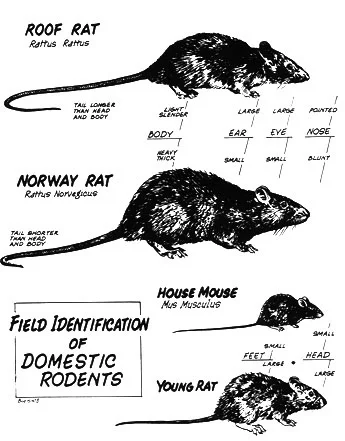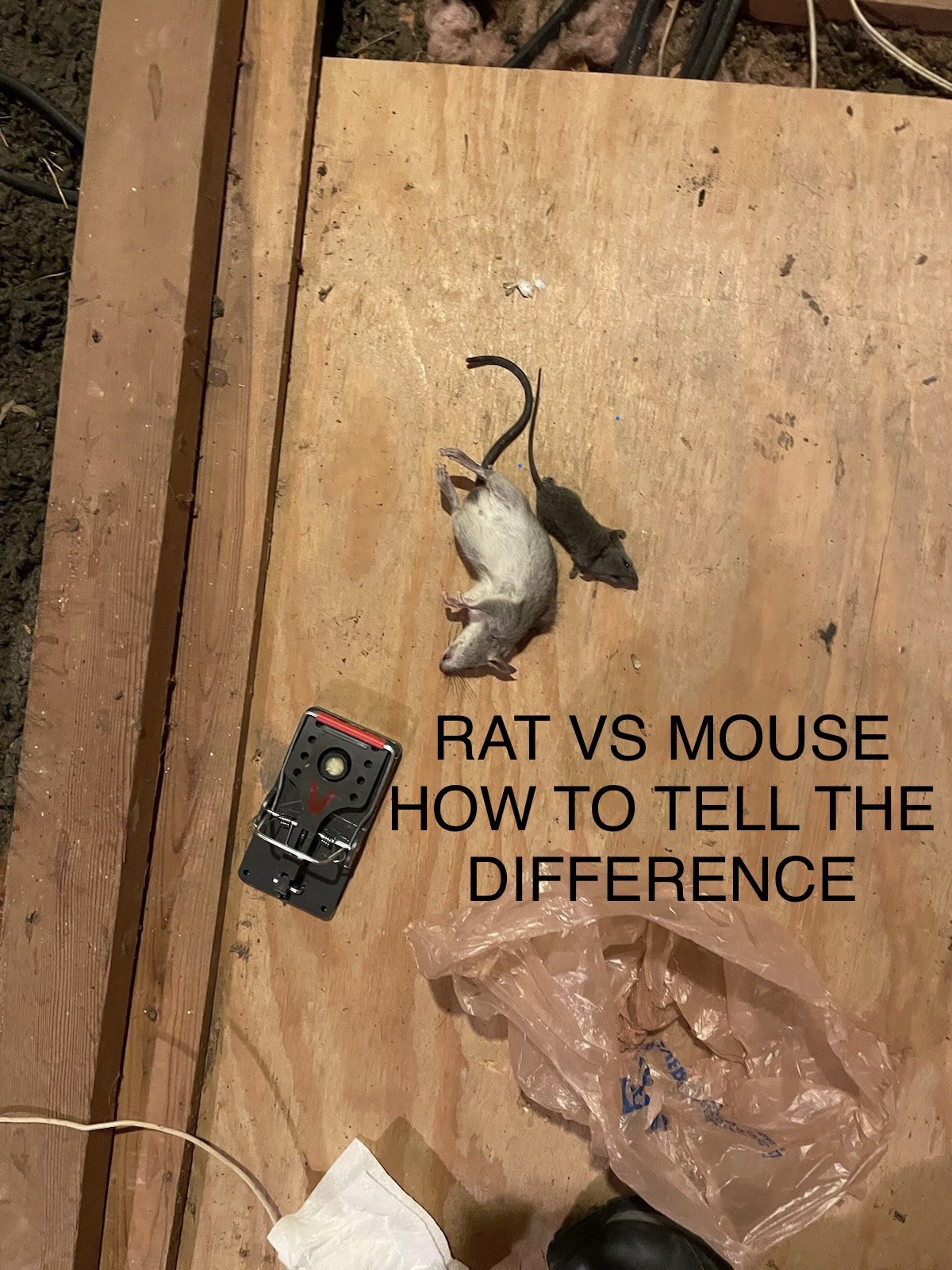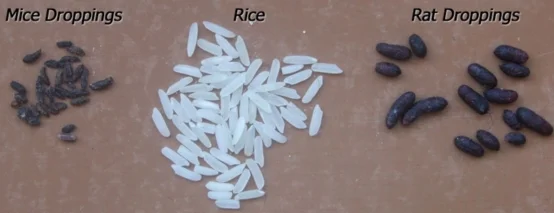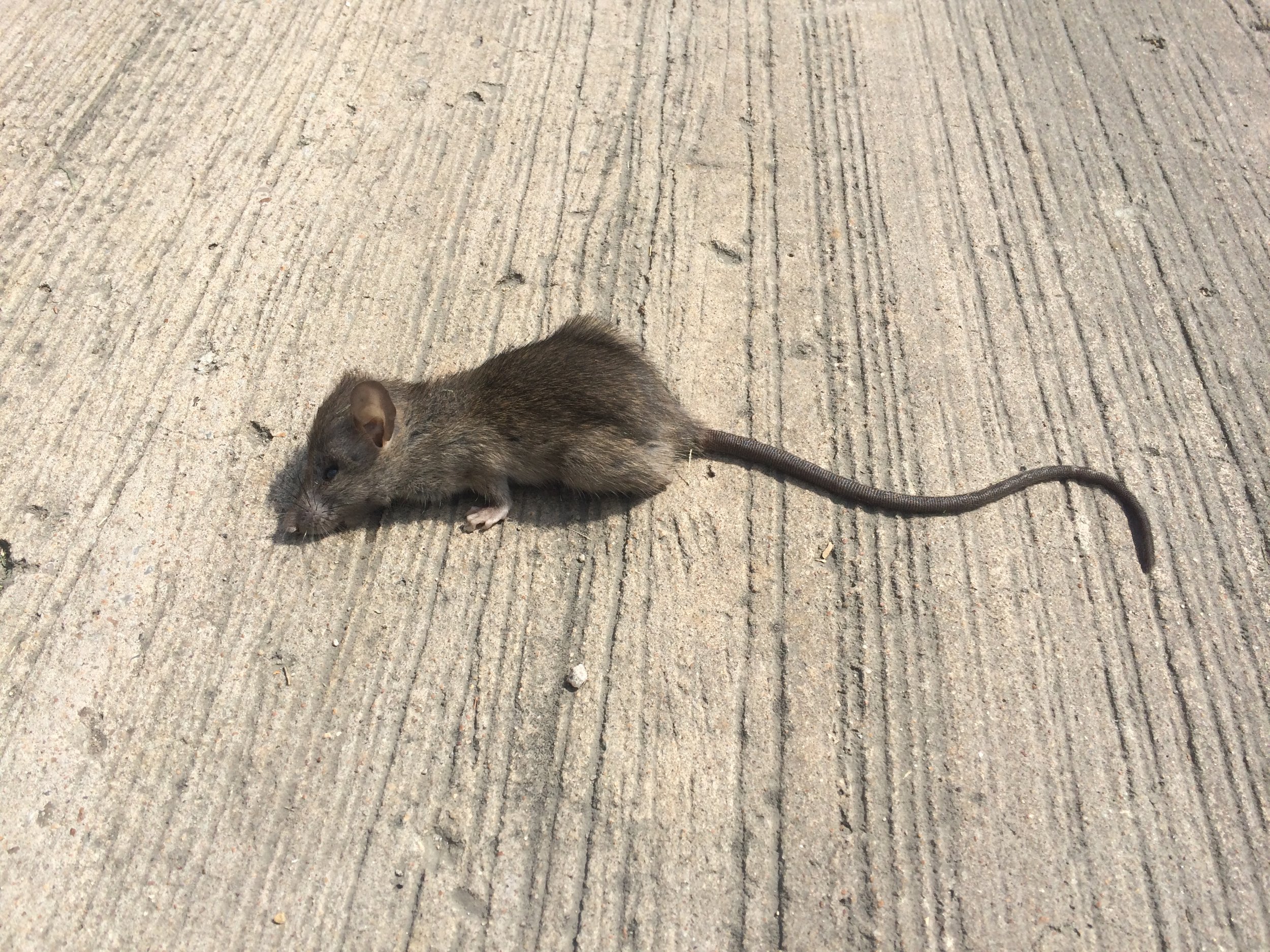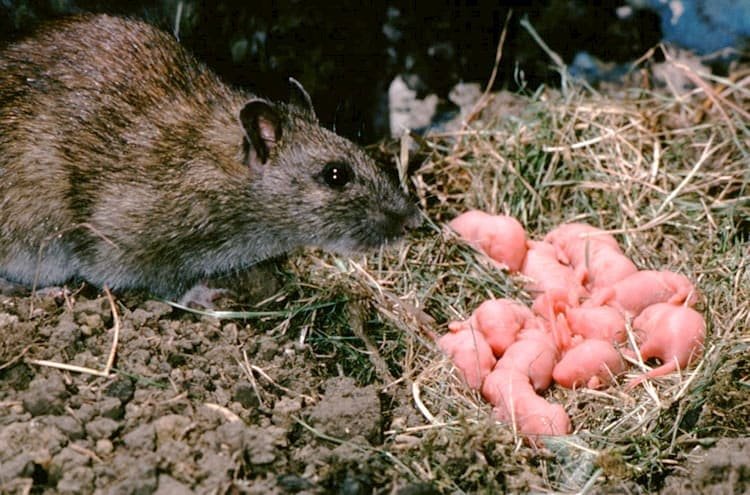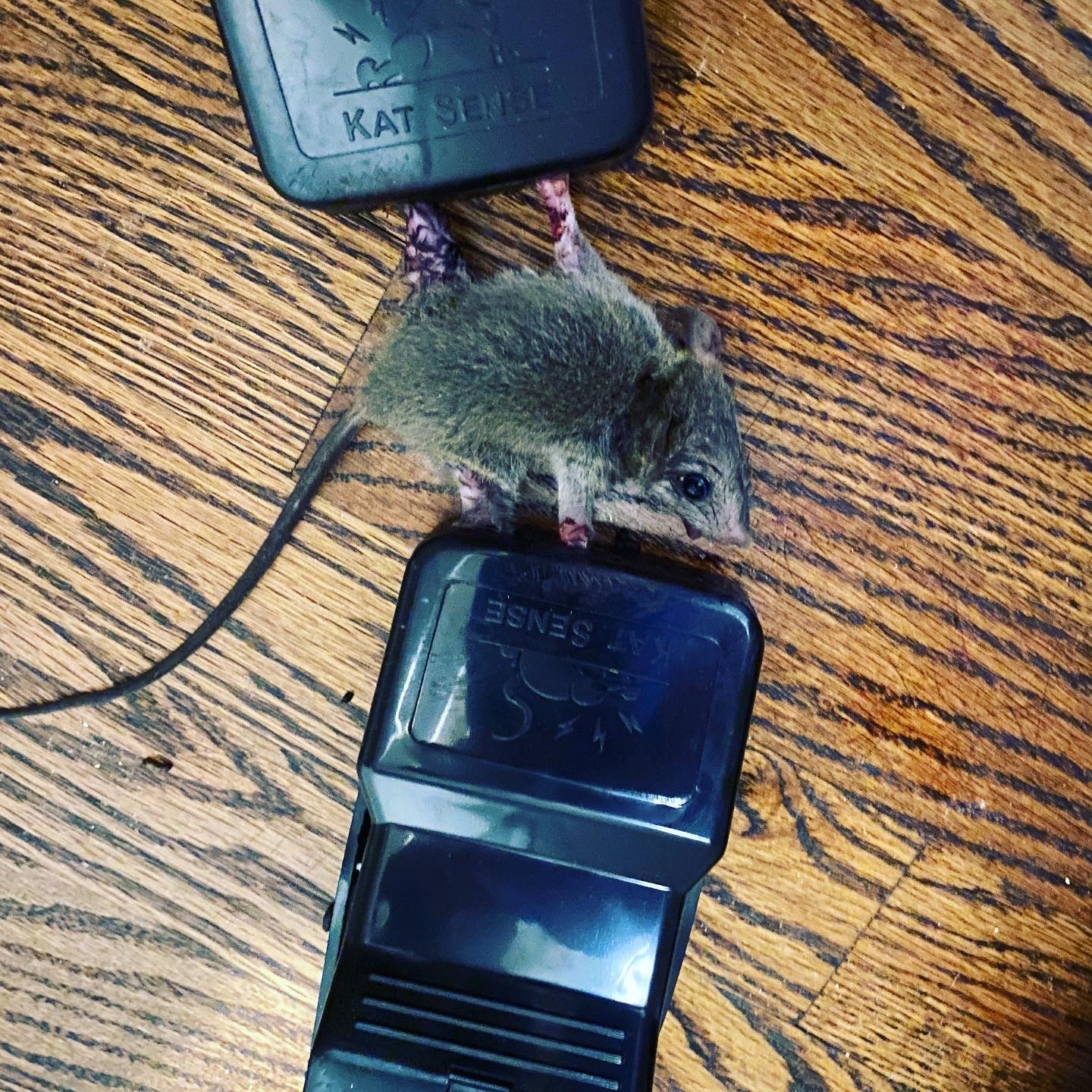What is the Difference Between a Rat and a Mouse?
Rats and mice are both rodents, so look similar - the biggest difference is their size. Rats are larger and heavier while mice have smaller slender bodies
Mice are often more brown than rats, and they have darker-toned bellies. While a rat's tail normally carries black, scaled rings, a mouse's tail is smooth.
Rats and mice are two different animals, but both belong to the rodent family, and share similar appearances with the most significant distinction being their size. Rats are notably larger and heavier, whereas mice possess smaller, slender bodies. Additionally, mice have long, slender, hair-covered tails relative to their body size, while rat tails are shorter, thicker, and devoid of hair, mice tend to be a bit bolder than rats.
We also find it worth mentioning that mice DO NOT turn into rats.
rat vs mouse side by side
Difference Between Rat and Mouse
HOW TO TELL THE DIFFERENCE BETWEEN A RAT AND MOUSE
(poop, size, behavior compared)
RAT VS MOUSE
There are several differences between rats and mice DO YOU KNOW THEM ?
Size: A Rat is larger and heavier than a mouse. Adult rats are generally about 8 to 10 inches in length, including their tail, and weigh around 8 to 12 ounces. In contrast, adult mice are generally about 5 to 7 inches in length, including their tail, and weigh around 1/2 to 1 ounce. Rat poop is bigger than mouse poop.
Body shape: Rats have thicker bodies and shorter, thicker tails than mice. Mice have slender bodies and long, slender tails.
Tail: Rats have shorter, thicker tails that are hairless, while mice have longer, hair-covered tails.
Color: Rats are typically brown or black in color, while mice are typically gray or brown.
Behavior: Rats are more social and tend to live in large groups, while mice are more solitary and tend to live alone or in small groups.
Diet: Rats are omnivorous and will eat a wide variety of foods, while mice are primarily herbivorous and tend to eat seeds and plants.
Habitat: Rats are more adaptable and can thrive in a wide range of environments, while mice are more selective and tend to prefer specific types of habitats.
Rodents, such as rats and mice, are commonly found in homes and businesses due to their ability to adapt to human environments. There are many types of rats, three main species that are prevalent pests: the Brown rat, the Ship rat, and the House mouse. The main difference between rats and mice is their size, with rats being larger and heavier and mice having smaller, slender bodies. Mice also have longer, hair-covered tails compared to the shorter, thicker, hairless tails of rats. Both rats and mice have incisor teeth in their upper jaw and short legs, but there are other distinguishing characteristics and habits that can help to identify which pest is present.
The three main species of rodents that are prevalent pests in homes and businesses worldwide are in need of rodent removal :
Brown rat (Rattus norvegicus): Also known as the Common rat or Norway rat, this species is larger and heavier than the other two main species.
Ship rat (Rattus rattus): Also known as the Black rat or Roof rat, this species is smaller and more agile than the Brown rat.
House mouse (Mus domesticus): This species has several subspecies that are common in different parts of the world, and these are increasingly being recognized as separate species. However, these subspecies are virtually indistinguishable from each other.
There are many different species of rodents, and some of these have subspecies. For example, the House mouse (Mus domesticus) has several subspecies that are common in different parts of the world, and these are increasingly being recognized as separate species. However, these subspecies are virtually indistinguishable from each other. Other rodent species may also have subspecies, but it would depend on the specific species in question.
In general, rodents are a diverse group of animals, with more than 2,000 different species that are found all over the world. They come in a wide range of sizes and shapes, and have adapted to many different environments, from deserts to forests to grasslands. Some common examples of rodent species include rats, mice, gophers, groundhogs, hamsters, guinea pigs, and squirrels.
What do mice look like?
Mice are small rodents with slender bodies and long, slender tails that are covered in hair. They have pointed snouts and large, round ears. Mice are typically gray or brown in color, although some species may have white, black, or tan fur. Mice have small, delicate paws with sharp claws, which they use for climbing and digging. Adult mice are generally about 5 to 7 inches in length, including their tail, and weigh around 1/2 to 1 ounce.
RAT VS MOUSE ?
What do rats look like?
Rats are larger than mice and have thicker bodies and shorter, thicker tails that are hairless. They have pointed snouts and small, triangular ears. Rats are typically brown or black in color, although some species may have gray or tan fur. Rats have strong legs with large paws and long, sharp claws, which they use for climbing and digging. Adult rats are generally about 8 to 10 inches in length, including their tail, and weigh around 8 to 12 ounces.
I can not tell you the number of times a client has told us at rapid rodent removal they have a mouse in their garage only for it to turn out to be a rat. Just the word, “rat”, can send shivers down the toughest man’s spine, even if its a dead rat. Nobody wants to have a rat problem, and need rodent control. They are big and terrifying. Their tails are just weird. And those beady eyes. Gah. If you had to choose a problem to have in your house, I bet you’d choose mouse. Small and unassuming, they are kind of cute when not living rent-free in your attic. They are obviously scared of you so no danger of it charging and biting your ankle. And how much damage can such a tiny creature really do?
These are the preconceived notions most people have about these two free-loaders. But are they accurate? Let’s take a deep dive into both rats and mice and see if we can find the true differences and similarities.
Let’s begin with some similarities. Both mice and rats are rodents, mammals in the order Rodentia that are characterized by their single pair of incisors in the lower or upper jaw which continuously grow throughout their life. They have good company in this order. Squirrels, beavers, porcupines, and gophers (just to name a few) all belong to Rodentia, too. Rodents are found throughout the world in various climates and environments due to their adaptability. However, in North America, we can narrow down your unwanted roommates a bit to three species. First up is the Brown Rat (Rattus norvegicus, also known as the Common Rat or Norway Rat). These are, you guessed it, brown (or sometimes gray). Next is the Ship Rat (Rattus rattus, also known as the Black Rat or Roof Rat). Black to light brown in color, this species of rat is thought to have originated on the Indian subcontinent, catching rides on ships to spread throughout the globe. Lastly, we have the House Mouse (Mus musculus domesticus). With a pointed nose and large round ears, this is the most abundant species of mouse.
frequently asked questions:
about the house mouse, rats, mice and other rodent species diets and behaviors
No matter if its a one mouse, or an entire rat or mice infestation, rodents are very adept at learning how to get in residential homes, and most customers report them ending up in thier attic or roof, which requires, you guessed it, rodent control.
Droppings - Rat poop vs Mouse poop compared
if its small like rice its from mice, if its kinda fat its from a rat (picture of rat & mouse poop)
What is the difference between rat and mouse droppings ?
When you run into your surprise house guest in the middle of the night it doesn’t matter which of these three species it is. You can exclaim, “My, what big teeth you have! And what a long tail I see! And what powerful legs you have!” Then hide in your closet and call 469-609-RATS.
What does rat poop look like ?
What does mice / mouse poop look like ?
What does squirrel poop look like ?
What does raccoon poop look like ?
What does opossum poop look like ?
Identification of Mouse vs Rat compared
So you have eyes on the perp and want to know which species you are looking at? Let’s compare their different appearances. A mouse has a smaller everything, nothing on a mouse is bigger than a rat.
A Rat has a slender body, pointed nose, and large, thin ears. Their tail is usually slightly longer than the length of their body and head combined.
RATS VS MOUSE AND MORE
identification of rat vs mouse
DID YOU KNOW mice tend to be a bit bolder than rats ?
Mice are easily distinguished from the two rat species by their considerably smaller size. A full-grown house mouse can be anywhere from 3-10 cm long (compared to a rat’s sizable 16-40 cm length!). However, it would be easy to get mixed up between an adult mouse and an adolescent rat. To distinguish the two, mice have large rounded ears (versus the oval, almost pointed ears of a rat) and their thin tail is usually longer than the length of their body (versus a thick tail shorter than their body, like rats). A young rat will have much larger feet and head when compared with their bodies than a mouse will. And mice are typically light gray or brown in color.
DID YOU KNOW rats are medium sized to large rodents but small on the mamal side ?
Now you’ve ruled out mouse from above but which species of rat is it? A Brown Rat will have a thick, stout body with small hairy ears and a blunt nose. Their tail is shorter than the length of the body and head with paler coloring underneath the tail.
DID YOU KNOW a mouse has smaller tail and is smaller in weight and length ?
A Rat has a slender body, pointed nose, and large, thin ears. Their tail is usually slightly longer than the length of their body and head combined.
did you know a roof rat is more cautious than a tiny house mouse ?
Rats vs mice compared : Young vs. adult
Young, weaned rats are still larger than adult mice, weighing around 100 grams at six weeks. However, to the casual observer, very young rats and adult mice can be difficult to tell apart.
Here's what to look for: baby rats will have more juvenile proportions than adult rodents. Their heads and feet will be large relative to their bodies, their faces will be stubby and blunt with wide noses. Adult mice, on the other hand, will have adult proportions: a small, triangular head with a small nose and little delicate feet as compared to the body. In addition, mouse ears are very large relative to their heads, rat ears are smaller relative to their heads. Rats also have thicker tails than mice.
Whether mouse, brown rat, or ship rat, call 469-609-RATS and we will come help you get rid of your unwanted guests.
rat vs mice Diet:
While most rodents are herbivores, sticking exclusively to plant materials for their nutrition, rats and mice are much less picky. Both are omnivores, meaning they will eat both plants and meat, oftentimes feeding on members of their own species if the opportunity presents itself. read our article on the best bait to use on a rat trap, or the best mouse trap bait
DID YOU KNOW norway rats are much larger and have coarser fur ?
Brown rats and mice both tend to look for food in the same area from night to night while ship rats move locations frequently, thus making their capture more challenging. They also prefer cereals to other foods while ship rats search for moist fruits (lookin at you, gardeners!). Despite these food preferences, I have had great luck using peanut butter, candy bars, and tuna on the traps. Who knew rodents had a sweet tooth?
DID YOU KNOW rats have proportionately larger heads and feet ?
Brown rats will drink up to 60ml of water a day (about ¼ cup) while ship rats only require half that. Shockingly, mice can survive up to a month with no water, making it hard to drought them out of your home.
rat and mouse traps
DID YOU KNOW rats have bodies that are five times larger than mice ?
A common draw for all three rodents is dog food and oftentimes it is for this reason people end up with rodents in and around their house. Those who store their dog food in their garage or on their porch will often find holes chewed into the bottom of the bag. The safest way to store dog food is to put it in a plastic or metal container with a locking lid and keep it somewhere indoors.
Rat and mouse habitat and health problems:
As we noted before, these three species can be found on every continent but let’s zoom in on their unique locations.
Brown rats usually live on the ground in burrows. They are also commonly found in sewer systems (Master Splinter?), often causing massive damage to the pipes. They use shredded materials to make their nests within their burrows.
rats are much larger have coarser fur and have proportionately larger heads and feet
Ship rats are, unsurprisingly, found mostly in coastal regions. You may be thinking, “Whew. Dallas isn’t coastal!” but we are in relatively close proximity to the gulf coast, making ship rats a common household pest here, too. Ship rats are climbers, living high up in trees when left to their own devices. If they find their way into your house, they will most likely be in your attic, using your insulation as a material for bedding and nesting.
DID YOU KNOW mice tend to be bolder than brown or norway rats species ?
Mice are a combination of both the rat species. While they love to burrow into the ground, they are also agile climbers, making themselves at home in trees and, yes, attics.
Signs:
More times than not, you won’t actually see the rodent. Instead, you will find a series of clues or hear noises that tip you off to their presence. Let’s briefly discuss a few of these signs you might notice.
Let’s talk poop. Brown rat droppings are wide and are a dark brown color. They are typically found in a tapered, spindle shape – resembling a large grain of rice. Ship rat droppings are long and thin, and are smaller than brown rat droppings. Ship rat droppings are more regular in form with a banana-like curve and pointed ends. Mouse droppings are approximately 3-8mm in length, and are often found scattered randomly. Mouse droppings are granular in shape and black in color, found most often near nesting areas.
Another sign you may see is smudging or streaking along the surface they are traveling. The brown rat tends to walk on the pads of the feet and the surfaces that it travels along show continuous smudges from the oily fur, whereas ship rats tend to walk on their toes and the surfaces that they travel along show separated smudges. Mice are, in my opinion, more disgusting in this regard than either rat. Grease from their body, combined with dirt and urine, build up into small pillars where they spend their time. These can remain for a long time, so their presence may not indicate a current infestation. A mouse will also, obviously, have a smaller footprint than a rat.
As far as damage is concerned, both can be capable of extensive amounts. Those teeth we mentioned at the beginning of this article, the ones that grow continuously, need to be constantly worn down to keep their length in check. Because of this, rats and mice chew on everything. Wires, pipes, siding, drywall. I have even seen a lot of cases where the rodents have chewed into the air ducts in the attic to benefit from the cool or warm air circulating through your home. This isn’t only damaging, but costly, too. I don’t think any of us want to be accidentally air conditioning our attics, especially in the middle of a Texas summer.
difference between baby rat and mouse
I hate to be the one to break it to you but if you have A rodent in your house, you most likely have Several rodents in your house. Let’s discuss their breeding habits to help you understand how quickly your small problem can become a big problem.
The newborns of all three rodents are blind, hairless and completely dependent on the mother for feeding and protection for the first several weeks of life. Mice, who breed faster than rats, reach sexual maturity between 4 and 7 weeks of age. The younger they are, the smaller their litters, having anywhere between 4 and 16 babies each time. This can happen up to 8 times a year (that’s more frequently than every other month, for those of you counting). The brown rat reaches sexual maturity sometime between 3-4 months of age. They begin weaning their litter around 4 weeks old but, fun fact, they don’t have to have weaned their litter before conceiving again. Their litter size is typically 7-8 and they typically breed 3-6 times a year. Ship rats are just slightly slower to conceive than brown rats, having a longer weaning period for their newborns. They reach sexual maturity around 3-4 months old, breeding only 6 times over the course of their 18 month lifespan (once every 3 months is a slight improvement, though I don’t think it makes me feel much better). They are capable of having 7-8 babies with each litter.
So, in one 6-month period of having a pair of male/female rodents in your attic, the female can have anywhere between 14-48 babies, depending on species. Assuming half of those babies are female, I don’t want to know the math on how big the population could be by the end of those 6 months. Any math experts out there care to do the calculations?
Difference Between a Rat & Mouse Behavior:
We started out this article with some preconceived notions about rats vs. mice. One of them was that a rat was more likely to chase and attack you while a mouse is probably more likely to be scared and avoid human contact. This is, in fact, backwards from reality.
Even though they are smaller in size, mice tend to be a bit bolder than rats. Mice are usually very curious creatures and will explore any new things they come across, including traps. Rats, on the other hand, are very careful and will choose to avoid new things in their path until they have had time to get used to them being there. You are unlikely to see them (until they are dead in a trap) and even less likely to be attacked by one. Just don’t corner it and it should scamper away.
Rats and house mice now have many genetic, reproductive, developmental, morphological and anatomical differences.
How does a rats behaviour differ from a mouse?
• Genetic differnces: rats have 22 chromosome pairs, house mice have 20 (see Levan 1991). rats have 2.75 billion base pairs while mice have 2.6 billion (humans have 2.9). About 90% of rat genes have counterparts in the mouse and human genomes
• Growth differences: In general, rats develop more slowly than house mice. For example, rat gestation is slightly longer (21-24 days) than house mouse gestation (19-20 days). rats lactate for about 3 weeks, house mice for 2 weeks. Both species are born naked and blind, but rats open their eyes at 6 days, they are fully furred at 15 days. House mice open their eyes at 3 days, have fur at 10 days (etc.).
• Anatomical differences: rats have 6 pairs of nipples, house mice have 5 pairs.
• Morphological differences: rats are larger, heavier and longer than house mice ( rat: 350-650 grams, 9-11 inch bodies and 7-9 inch tails; house mice: 30-90 grams, 3-4 inch bodies and 3-4 inch tails). Correlated with this larger size, rat body parts are larger than those of the house mouse -- rats have larger ears, feet etc. The heads of rats are heavy, blunt and chunky, house mouse heads are small and sharply triangular with pointed muzzles. Note, however, that rats have smaller ears relative to their heads than house mice.
Mouse-killing behavior in rats is called muricide by professionals
Rats can, and do, kill mice, a behavior known as muricide. Muricide is a form of predatory behavior: rats hunt, kill and eat mice.
How common is muricide?Karli (1956) found that about 70% of wild rats and 12% of domestic laboratory rats kill mice. Male and female rats are equally likely to kill mice. Similarly, Galef (1970) found that 67% to 77% of captive born wild rats kill mice.
Description of muricideMuricide is a stereotyped behavior, performed in much the same way each time: the rat chases the mouse around the cage and bites it using its sharp front incisors, usually aiming for the mouse's head, neck, or upper back. The first bite is frequently fatal, but the mouse may delay the rat's attacks by defending itself (by rearing up and boxing with its front paws or laying on its back). Eventually, however, the rat delivers a fatal bite. Mouse-killing behavior is very rapid, lasting only a few seconds.
The preferred area to bite is the back: out of 671 mice killed by rats, 89% were bitten on the spinal cord (specifically: 65% neck, 13% thoracic, 11% lumbar). Only 7% were bitten on the belly and 4% were bitten on the head.
Do rats eat the mice they kill?Karli (1956) found that all mouse-killing rats (wild or domestic) consumed part of the mice they killed. Specifically, out of 683 mice killed by rats, after 7 hours 25% of the mice had been entirely eviscerated (brain, thoracic and abdominal viscera), 67% had been partially eviscerated, and only 8% had not been eaten.
Wild rats tended to start eating at the spot where they had bitten the mouse, which is usually the neck. They gradually opened the thorax and consumed the thoracic viscera, then proceeded to the liver. In contrast, domestic rats went right to the brain, opening the skull and consuming all or part of the brain, no matter what killing method had been used.
Exogenous and endogenous influencesMouse-killing is a complex behavior involving several neurotransmitter systems
Mouse-killing is also affected by by rearing , environmental conditions, social conditions, diet, learning. Rats are more likely to kill mice at night than during the day.
Mouse-killing is affected by hunger, too: rats kill mice more when they are hungry and at times when they are normally inclined to eat food. Rats may start killing mice when they are starving, but stop when they are given plenty of food .
Familiarity with mice also plays a role: rats reared with mice tend not to kill mice as adults. Specifically, Galef found that 67-77% of captive born wild rats kill mice. However, if captive born wild rats are raised with a mouse from weaning to age 3 months, none of them kill the mice they're familiar with. When presented with an unfamiliar mouse, only 7% of the mouse-reared rats killed it.
Response of mice to ratsRat odor is stressful to mice and has an effect on their behavior and reproduction. In fact, rat odor is sometimes used as a predator odor to study anxiety and antipredator behavior in mice.
Specifically, domestic and wild-stock mice who are exposed to a conscious or anesthetized rat tend to flee, and if prevented from fleeing, they show defensive or attack behavior.
Mice housed in the same room as rats tend to be more stressed than mice housed without rats. Mice who can smell rat urine take ten times longer to start eating a treat than mice who cannot. Mice who were exposed to rat urine for just a few minutes startle more afterwards, even up to two days after the rat urine exposure. Pregnant mice exposed to rat urine produce fewer litters than mice who were not exposed.
The Norway rat and the house mouse had a common murine rodent ancestor. How long ago that common ancestor lived is a matter of debate, however. The fossil record indicates that the most recent common ancestor of Norway rats and house mice lived about 8-14 million years ago. Geneticists, however, estimated that their most recent common ancestor lived about 41 million years ago.
Brief history of house miceThe ancestors of the house mouse (Mus musculus) lived in the steppes of present-day Pakistan. Ten thousand years ago, at the end of the last ice age, neolithic farmers moved from the Fertile Crescent into the steppes of Pakistan, and these small rodents found a delightful new source of food and shelter.
When humans migrated away from the steppes to colonize other areas, mice went along as stowaways in the humans' carts and later, their ships. House mice arrived in the new world in the 16th century, arriving with explorers and colonists. Mice went everywhere with humans, living in and around their houses, a human-dependent association called commensalism. Today, commensal house mice live in and around human dwellings on every continent, in every climate.
mice and rats and health problems compared & different types offspring characteristics frequently asked questions ie : a mouse is smaller , a rat is more cautious
Today, commensal house mice are divided into four subspecies: M. musculus bactrianus are the descendants of the original, ancestral house mice first encountered by our neolithic ancestors. They live in India, Pakistan and Afghanistan. M. musculus castaneus lives in Southeast Asia. M. musculus musculus lives in Russia and western China, and M. musculus domesticus lives in Europe, from whence it traveled to the Americas, Australia, New Zealand, and Africa with the colonists.
Domestication: Domestic mice originated from stocks captured in China, Japan and Europe and developed into fancy mice. These fancy mice were found in pet shops in the 20th century, and were developed into laboratory mouse strains. Fancy mice are primarily descended from M. musculus domesticus, with a little admixture of the other three subspecies. As such, domestic mice do not represent one of the single subspecies, but are a mixture of all four.
how rats and mice are different in size, fur, weight, tail length, dropping characteristics, diet, lifespan, breeding habits, and the damages they cause.
Rat Identification
From the Norway rat to the roof rat, these rodents are known for being larger than their mouse counterparts.
Rats have thicker bodies and tails that are shorter than the length of their body.
They possess small hairy ears and larger feet.
They weigh anywhere from 150 to 300 grams.
Rat droppings are banana-shaped and much bigger than mice droppings at 10–20 mm long.
Rats produce 3–6 litters a year with up to 10 pups in each litter.
Rats are adventurous, omnivorous eaters who will feed on a variety of grains and meats.
They forage overnight and nest in garages, trees, and basements.
Mice/Mouse identification
Mice are typically significantly smaller than rats and exhibit different behaviors. Here’s how to tell them apart:
The house mouse is usually just 2–4 inches long.
Mice have larger ears and a longer tail compared to its body length.
Mice are often gray or brown in color, with a lighter shade or white color on their bellies.
Mice droppings have pointed ends and are just 1–2 mm long.
Most mice feed on fruits, seeds, grains, and occasionally meat.
They produce 5–10 litters a year with up to 14 mice in each litter.
Mice forage at dusk and nest in attics, garages, basements, and more.
Starve
Rodents will eat almost anything! Starve them out by eliminating potential sources of food.Use a trash can with a lid. Provide enough garbage cans with tight fitting lids to hold all garbage between pickups.
Bring garbage to the curb as close to pick-up time as possible. Garbage left on the curb for too long attracts rats.
Rinse containers before placing in recycling bin.
Keep outside cooking areas and grills clean.
Pick up dog poop regularly.
Don’t leave pet food outside.
Don’t leave food outside for stray cats, pigeons, or squirrels.
Keep bird feeders away from the house, and use squirrel guards to limit access to the feeder by squirrels and other rodents. If possible, don’t leave bird feeders out overnight. Use "mess-free" seed, or place bird feeders over concrete so you can sweep up any dropped seed.
EvictAttack their favorite places to seek shelter and reproduce.Clean up any clutter or litter in and around your yard.
Get rid of old trucks, cars, and old tires that rats could use as homes.
Remove piles of newspapers, paper bags, cardboard, and bottles in your yard.
Store items away from walls and off the ground.
Move woodpiles far away from the house.
Remove dead trees and stumps.
Rodents are often found in burrows under bushes and plants. Keep tall grass, bushes, shrubs, and mulch away from building foundations.
Keep grass cut short and shrubbery well trimmed.
Make space between plants and avoid dense planting.
Keep gardens free of weeds and trash.
Look for - and fix - gaps or holes outside your home so rodents can’t get inside.
In the roof among the rafters, gables, and eaves.
Around windows.
Around doors.
Around the foundation
Attic vents and crawl space vents.
Under doors.
Around holes for electrical, plumbing, cable, and gas lines.
Materials can be found at your local hardware store to fix gaps and holes:
Use caulk to seal small holes and cracks.
Fill slightly larger holes with steel wool. Put caulk around the steel wool to keep it in place.
Use lath screen or lath metal, cement, hardware cloth, or metal sheeting to fix larger holes.
Close gaps under doors with rodent-resistant metal door sweeps.
Close window gaps with metal flashing.
Use flashing around the base of the house, and fix any gaps in trailer skirting.
Use 1/2 inch mesh hardware cloth as a barrier under decks, porches, and crawl space openings.
Put screens on vents, especially on lower floors.
Seal pipes leading into walls with escutcheon plates (“pipe collars”). Check pipes regularly for leaks.
Outbuildings and garages should also be sealed to prevent the entrance of rodents.
An inactive burrow will often have leaves, cobwebs or other debris around the entrance. These burrows should be closed so rats can’t get back in.
Close burrows in soil by filling with soil and tamping down with a shovel, or by stepping on them.
Close burrows in cracked or broken sidewalks with metal filler and cement.
some of the information on this page was found on ratbehavior.org , we suggest you give them a gander for great information on all things rodent related.
MICE VS RATS
No matter what species of rodent you have living on your property, call us to take care of it. We have seen it all and know just how to handle it. 469-609-RATS
What is the difference between a rat's diet and a mouse's diet?
Rats consume far more food than mice to feed their larger bodies. They tend to favor protein-rich foods such as meat, cheese, fish, and pet food. On the other hand, mice prefer a healthier diet of fruit, vegetables, nuts, and grains.
That said, rats and mice are very adaptable—they’ll eat whatever they can get their paws on. In fact, mice will even eat their tail if they don’t have access to any other food.
plants or Foods that attract Mice and Rats
Here’s a fact to share with your friends: rats have a stomach size of up to 267 grams. In fact, a rat’s stomach is about half the size of your thumb! Mice’s stomachs are far smaller, and they have a less voracious appetite compared to rats (although your damaged home may not agree).
As you can imagine, mice and rats vary drastically in their weight. A mouse’s weight ranges from 0.5 to 1 ounce, whereas rats weigh up to 16 ounces and above.
Mice and rats have big appetites. Mice can eat up to 3 grams every day, and rats can eat up to a third of their body weight.
You likely don’t need us to tell you that house mice and rats have a wide-ranging diet. However, you might be wondering: what kinds of foods attract mice and rats? Below are some of the most common mice and rat-friendly foods.
Fruit and BerriesMice and rats have an expensive taste of their favorite food source—they love fruits, especially raspberries and blackberries. Apples and pears are also a go-to meal for them. They love the sweet smell of rotting fruit just as much as the fresh stuff, so take care when throwing away fruit scraps.
NutsA high source of protein, rats and mice love to lap up this energy-dense food. They aren’t picky about the type of nut; anything from peanuts to hazelnuts will satisfy them.
PlantsIt may not be their first choice, but mice and rats eat grass, twigs, and bark. Rats tend to go for larger plants, and mice stick with smaller ones.
Grains and SeedsFrom oats to sunflower seeds, rats and mice love eating seeds from your bird feeders and bags of feed you may have sitting around a barn. Grains and seeds are among the most natural kinds of foods for them.
MeatRats are bigger meat eaters than mice. They don’t discriminate on cut or style—a rotten piece of liver makes them just as happy as fresh filet mignon.
Garbage Scraps and TrashIt’s no secret that rats and mice love eating items out of the trash bin. It’s an opportunity for them to enjoy a wide range of nutrient-rich nibbles of bread, cheese, meat, and desserts.
Pet FoodMice and rats are more than happy to share Fido’s food. They’ll even eat fish, food, and hay for livestock.
Food and Animal Byproducts Non-edible items like clothes made from animals, including leather, are all tasty treats for rats and mice if there isn’t anything better around to eat.
Salty and Sweet FoodsLike humans, rats and mice love their salt and sugar. They’ll eat everything from chocolate to gumdrops.
Are there different species of rats and mice?
Mice and rats are both rodents, and they have many similarities and differences. One of the main differences between mice and rats is their size. Mice are smaller than rats, while rats are medium sized to large rodents. This size difference can be seen in the proportion of their body parts as well. Mice tend to have smaller heads and feet compared to their body size, while rats have proportionately larger heads and feet. Another difference between mice and rats is their fur. Mice tend to have softer fur, while rats' fur is more coarse. This difference in fur texture can be attributed to the fact that mice are generally more agile and active, while rats are more cautious and tend to move slower. In terms of behavior, mice tend to be a bit bolder than rats. They are more curious and exploratory, while rats are more cautious and calculated in their movements. This difference in behavior can also be attributed to their size, as smaller animals tend to be more agile and quick to react. However, both mice and rats are capable of causing damage to property and household items. An individual rat can cause much more damage compared to a mouse, due to their larger size and strength. Rats, with their big heads and large teeth, have more of a heavier, blunt shape snout, which they can use to chew through various materials. Meanwhile, mice have bodies that are five to seven inches long and are generally more delicate in their movements. In conclusion, mice and rats are both rodents that can coexist in human environments. While they have many similarities, they also have significant differences in terms of size, fur texture, and behavior. Understanding these differences can help individuals distinguish between the two types and take the necessary precautions to prevent damage or infestations.
RAT VS MOUSE SUMMARY
Rats vs. Mice Products Needed for Rats vs. Mice Solutions Rat & Mouse Bait Station
In terms of behavior, mice and rats are active primarily at night, and they are known for gnawing on a variety of materials to keep their constantly growing incisors filed down. They are also known for being excellent climbers and can easily access attics and roofs through small openings. Rodent infestations should be dealt with promptly as they can cause damage to structures, spread diseases and contaminate food sources.
Frequently asked questions: about the house mouse, rats, mice and other rodent species diets and behaviors No matter if its a one mouse, or an entire rat or mice infestation, rodents are very adept at learning how to get in residential homes, and most customers report them ending up in thier attic or roof, which requires, you guessed it, rodent control.
large portions of this article were written citing ratbehavior.org , a phenomenal website i read to my kids about our pet rats, be sure to check it out
In an attempt to remind customers that Rapid Rodent Removal are also roofers, we have also made a table of contents with all of our information about rats , mouse , squirrels and Roofing , Roof Repair , Roof Replacement (articles & blog) stemming from to all about Rat poop , Mouse poop , Squirrel poop or Raccoon poop in Your Home & or Rats in Attic, to Roofing Contractors to Rodent Control.


